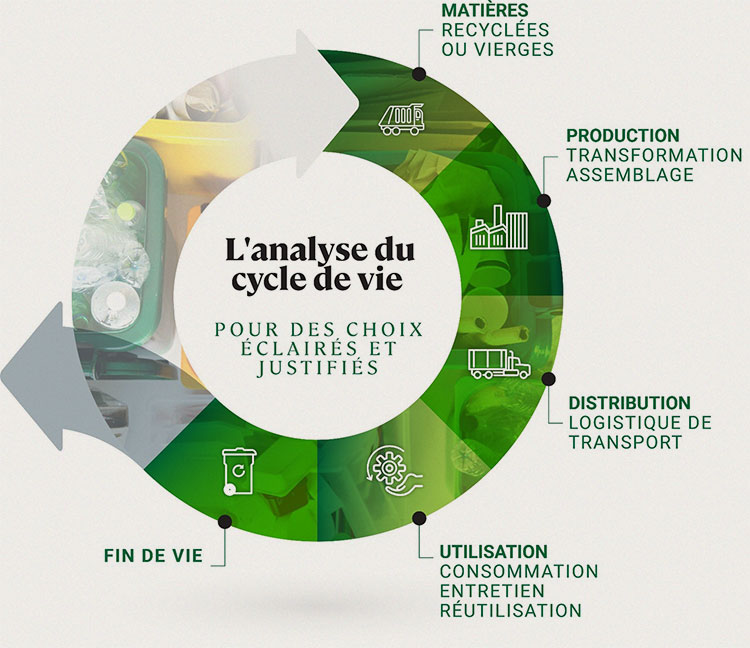Consume less, consume better. At a time when climate change is a concern, people are looking for concrete ways to reduce their ecological footprint.
Retailers, grocers, distributors, processors and more are being questioned by consumers who want to buy greener. How can they reassure consumers about the impact of products they offer, and how can they themselves ensure that they are making environmentally responsible purchases from manufacturers?
A manufacturer whose products undergo life-cycle assessment (LCA) can clarify these choices by providing objective answers through a rigorously conducted science-based process.
360-degree environmental picture
There is an abundance of products promoted as "environmentally responsible." However, distinguishing which ones actually have a smaller footprint remains a challenge. Exactly what criteria must be met for a product to be considered “environmentally responsible”? What about its inputs? Its recyclability? The amount of recycled material it contains?
Each stage in a product's "life" influences its environmental impact. Toilet paper, boxes, cars, cell phones... life cycles differ greatly from one product to another. From the beginning of a product's creation to the end of its use, decisions are made, transportation, energy and other resources are consumed. All these factors make up the product's overall footprint.
LCA makes it possible to scientifically measure the environmental impacts of a packaging or hygiene solution. This rigorous approach evaluates the product's environmental performance at each stage of its life cycle, providing an overall picture of its impacts. This method is recognized worldwide and governed by ISO (International Organization for Standardization) 14040-44.
LCA is Cascades’ preferred approach for assessing the eco-responsibility of its packaging and hygiene solutions. The company submits several of its products to organizations specializing in independent life cycle assessment, whose results can be shared with its customers.

Eco-design: Developing a sustainable footprint
Conversely, the fundamentals of LCA can guide a manufacturer's choices when developing a potentially eco-responsible product.
Designing a packaging or hygiene solution with a small environmental footprint involves upstream consideration and decisions before going to the drawing board. That's the basis of the "eco-design" concept. Cascades relies on the fundamentals of eco-design to develop its new products and innovates by seeking to reduce their footprint during their life cycle.
LCA-based eco-design helps identify opportunities for improvement in the early stages while avoiding the displacement of impacts from one stage of the life cycle to another. For example, replacing the inputs for a packaging product with another option perceived as more environmentally friendly, but one that would make the product non-recyclable, could have the effect of increasing the product's overall footprint.
From the choice of inputs to end of life
As a general rule, using recycled material instead of virgin material to manufacture a product positively influences its environmental footprint. Obviously, sourcing recycled inputs requires the presence of recyclable products on the market. Cardboard, paper, moulded pulp, plastic... there is a wide range of recyclable materials, but several factors influence their recyclability potential.
Although we talk about a product's "end of life", it's at the beginning of the eco-design process that decisive choices for this stage are made. Recyclable, compostable, disposable... a product's end of life is another criterion used to evaluate its environmental performance. There are many factors that influence the path taken by a product once it has played its role and made its actual contribution to the circular economy.
For example, the transparency and color of a package can influence its recyclability potential. The addition of certain additives to hygiene solutions, by their nature or quantity, can compromise the solutions' compostability.
From the moment a product is designed, choices can influence its path and the size of its footprint. Cascades' experts know the nuances of eco-designing and developing packaging and hygiene solutions according to criteria that promote their potential for a second life.
The marriage between container and content
LCA can also highlight determining factors beyond the product itself. For example, when you consider the full life cycle of a food, it generally has more impact than its container. So protecting it properly is an essential part of the equation.
Eco-design helps develop packaging that reduces food waste. The materials used, conservation technology, design, among more, are ways of adapting packaging to the food it protects to extend shelf life and minimize loss.
LCA provides a comprehensive view that helps target action priorities to truly reduce a product's environmental impact with reliable data to back it up.
Subject matter experts
Cascades supports its customers in their transition to more environmentally friendly products. Many of our hygiene and packaging solutions undergo a life cycle assessment with its reculting data helping our clients make informed choices based on science.